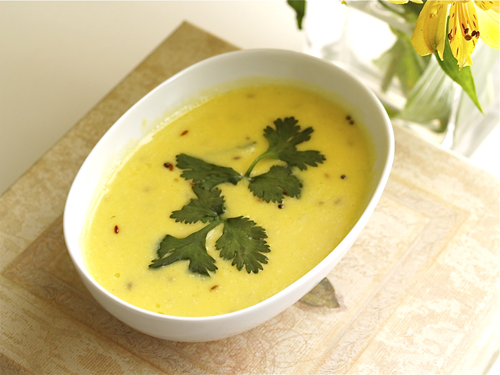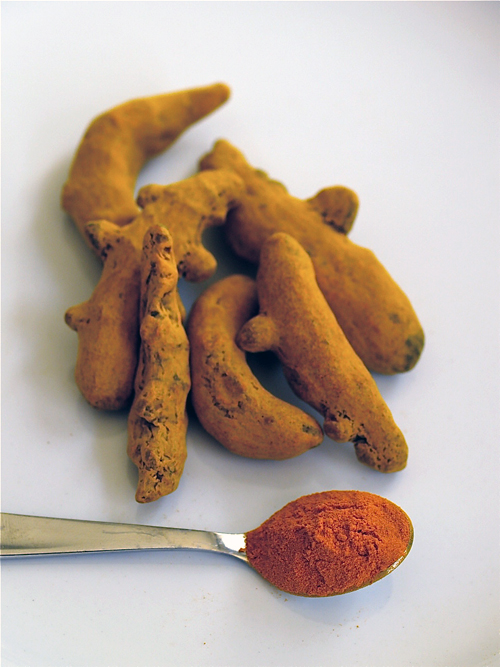Turmeric imparts a rich, ochre yellow to anything it is added to. The mustard so popular on hot dogs gets its color and part of its distinctive flavor from this golden spice. Turmeric is famous for its inclusion in curry powders. Marco Polo noted the following about turmeric when he came across it in 1280: “There is also a vegetable which has all the properties of true saffron, as well the smell and the color, and yet it is not really saffron.” This isnʼt entirely true. Turmeric and saffron can both turn things yellow. The similarity ends there. Saffron is fragrant and enchanting, its flavor elevated and floral. Turmeric smells a bit acrid; Its flavor is earthy, reminiscent of ginger and mustard.
Turmeric in Indian cooking is used primarily in its dry, ground form. Just a small amount is more than enough to convey the ginger-peppery flavor. In some parts of India, turmeric leaves are used to wrap dumplings before steaming. There is a milder flavor and flowery aspect associated with the leaves that is different from the stem from which the powdered spice is derived.
Forming the base on which several dishes can be built, turmeric, along with asafoetida and mustard seeds, are featured in countless recipes from the Indian sub-continent. Lentils, vegetables, meat and fish, all do well with a seasoning of turmeric. One of the simplest dishes featuring turmeric is also the most satisfying. Called kadhi, different regions of India have their own versions; it tends to have a thinner consistency in the south as compared to the north. It can be plain or made with chickpea dumplings (pakoras).

Buttermilk Kadhi
Serves: 3-4
Ingredients:
2 cups buttermilk
1/2 cup chickpea flour (besan)
1/3 tsp asafoetida
1/4 tsp turmeric
3-4 green chillies, split lengthwise (Serrano or Thai chillies)
1/2 tsp grated fresh ginger
1 tsp sugar
Salt to taste
Cilantro for garnish
For seasoning:
2 tbsp clarified butter (ghee) or canola oil
5-6 curry leaves
1 tsp asafoetida
1 tsp cumin
Preparation:
1. In a pot, combine the buttermilk, chickpea flour and 2 cups of water. Stir together to dissolve any lumps.
2. Add sugar, salt, turmeric and asafoetida and mix.
3. Move the pot onto the stove on medium high heat and bring the mixture slowly to a boil, stirring constantly. Add more water to thin it down if the mixture is still too thick. (The ideal consistency would be like tomato soup).
4. When the buttermilk comes to a boil, add the green chillies and ginger.
5. In a separate small pan, heat the ghee or oil to prepare the seasoning. Add mustard seeds (which should begin to splutter if the oil is hot enough) followed by cumin, asafoetida and curry leaves. Continue to heat gently for a few seconds to season the oil or ghee.
6. Pour the spiced oil into the buttermilk mixture. Stir everything to incorporate.
Garnish with some cilantro and serve.
Notes:
Keep stirring the mixture as it starts to boil to prevent the buttermilk from curdling and separating. Once it has reached a boil, the thickening of the chickpea flour keeps the ingredients emulsified. Though oil can be used here, try and use ghee. There is a voluptuousness of flavor that ghee brings to the dish. Also, if using oil, make sure it is neutral tasting like canola or peanut oil. An oil like olive oil tastes too strong and would disrupt the other flavors.
Though traditionally served on steamed rice, kadhi can also be served with chapatis or enjoyed just by itself. It is rare to find this dish in restaurants. This is home-cooking at its most basic. You could try variations by including some carrots or peas in it. Serve with rice and an Indian spiced pickle or papad, to create a simple and nutritious Indian comfort food dish.

